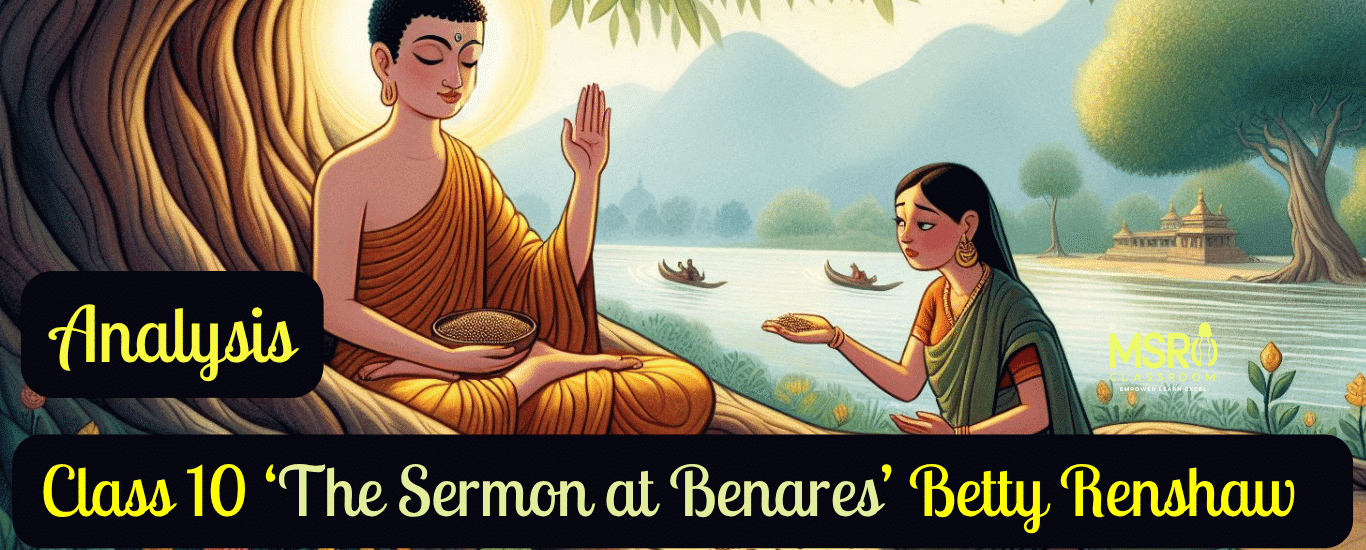Chapter 8, ‘The Sermon at Benares’ Summary, Theme, Word Meanings, Important Excerpts, Questions Answers with Additional Questions.
Table of Contents
Supplementary Reader: Class 10- Footprints Without Feet
Vocabulary:
| Afflicted: Affected by something painful or harmful; suffering from a condition. Alas: An expression of sorrow or regret. Arrow of lamentation: A metaphorical phrase representing the pain and sorrow caused by loss. Blessed: Made holy or consecrated; enjoying happiness and peace. Composed: Calm and in control of one’s emotions. Desolation: A complete emptiness or destruction; great sadness or loneliness. Enlightenment: A state of gaining knowledge or insight, especially regarding spiritual understanding. Inscrutable: Impossible to understand or interpret; mysterious. Lamentation: The passionate expression of grief or sorrow; weeping. Mortals: Human beings, especially in contrast to divine beings, are subject to death. Mustard seed: A small seed from the mustard plant, often used metaphorically to represent something small that can grow into something significant. Sakyamuni: A title for the Buddha, meaning “the sage of the Sakya clan.” |
Summary ‘The Sermon at Benares’:
Gautama Buddha was born as Prince Siddhartha in northern India. After seeing suffering for the first time, he left his royal life to find the truth about sorrow. He meditated under a Bodhi tree and became enlightened, known as Buddha. In his first sermon at Benares, Buddha shared a story about Kisa Gotami, a grieving mother whose only son died.
She asked Buddha for medicine, and he told her to find mustard seeds from a house where no one had died. After failing to see such a house, she realised that death is a part of life. Buddha taught that mourning does not help, and to find peace, one must overcome grief and accept death as a natural part of life.
Based on an excerpt from Betty Renshaw‘s Values and Voices: A College Reader (1975).
Theme ‘The Sermon at Benares’:
Acceptance of Death and Overcoming Grief:
The theme of this excerpt focuses on the certainty of death and how to deal with grief. Through Kisa Gotami’s story, Buddha teaches that death is a natural part of life, affecting everyone. Kisa learns that no family is free from losing loved ones, and her sorrow is not unique. Buddha explains that grieving too much does not help and only makes a person suffer more.
Instead, people should accept death as a part of life and move past sorrow. The Buddha encourages people to stop mourning, accept the truth about life, and find peace by letting go of their grief. Understanding and accepting death leads to peace of mind and freedom from suffering.
Character Sketch ‘The Sermon at Benares’:
1. Character Sketch of Kisa Gotami:
1. Role: Kisa Gotami is a grieving mother who has lost her only son.
2. Emotional State: She is initially overwhelmed by her grief and is desperate to find a way to bring her son back to life.
3. Actions:
- She goes from house to house seeking medicine for her dead child, showing her refusal to accept reality.
- She meets the Buddha and believes he can help her, demonstrating her hope and faith.
4. Transformation:
- Kisa’s journey leads her to realise that death is common to all families, shifting her perspective on her loss.
- She learns to accept her grief and understands the importance of letting go of selfish sorrow.
5. Final Insight: Accepts the inevitability of death and finds peace, embodying wisdom and resilience.
6. Significance: Represents the journey from sorrow to enlightenment and acceptance in the face of suffering.
7. Conclusion: Kisa Gotami evolves from a mother in despair to someone who understands the nature of life and death, finding a path to inner peace.
2. Character Sketch of Buddha: The Enlightened Teacher:
1. Identity:
- Known as Gautama Buddha, the Enlightened One.
2. Background:
- Formerly, Prince Siddhartha left royal life to seek truth and understanding of suffering.
3. Wisdom:
- He provides profound insights into life, suffering, and the inevitability of death, teaching that grief is common to all.
4. Symbolism:
- He attained enlightenment under the Bodhi Tree, symbolising the quest for wisdom and truth.
5. Compassion:
- Shows empathy towards Kisa Gotami, guiding her towards understanding rather than merely offering a solution.
6. Teaching Method:
- He uses relatable stories (like Kisa Gotami’s) to convey deeper truths about human existence and acceptance of death.
7. Focus on Detachment:
- Emphasises the need to “draw out the arrow of lamentation” to find peace and overcome sorrow.
8. Recognition of Suffering:
- Acknowledges that life is troubled and brief, reinforcing the importance of accepting death as part of life.
9. Role in Transformation:
- Guides Kisa Gotami from grief to understanding, highlighting his role in her emotional growth.
10. Legacy:
- He represents the path to wisdom, emphasising the journey from ignorance and sorrow to enlightenment and peace.
Questions Answers ‘The Sermon at Benares’:
Thinking About the Text:
Q1: When her son dies, Kisa Gotami goes from house to house. What does she ask for? Does she get it? Why not?
A1: Kisa Gotami’s First Journey
- What She Asks For: When Kisa Gotami’s son dies, she goes from house to house, asking for medicine to cure her child.
- Does She Get It?: No, she does not get the medicine she seeks.
- Why Not?: The people she asks tell her that her son is dead and that she has lost her senses. They feel sorry for her but cannot help because there is no medicine for the dead.
Q2: Kisa Gotami again goes from house to house after she speaks with the Buddha. What does she ask for the second time around? Does she get it? Why not?
A2: Kisa Gotami’s Second Quest
- What She Asks For: After speaking with the Buddha, Kisa Gotami goes from house to house again, asking for mustard seeds.
- Does She Get It?: She does not get the mustard seeds.
- Why Not?: The Buddha told her that the mustard seeds must come from a house where no one has died. When she asks the people, they all reveal they have lost loved ones. Kisa realises that death is common to everyone, and she cannot find a house without loss.
Q3: What does Kisa Gotami understand the second time that she failed to understand the first time? Was this what the Buddha wanted her to understand?
A3: The second time Kisa Gotami goes from house to house, she realises that death is a natural part of life and everyone experiences loss. She understands that she is not alone in her grief; everyone has lost someone they love.
Was This What the Buddha Wanted Her to Understand?: Yes, this is precisely what the Buddha wanted her to understand. He wanted her to see that suffering and death are universal. By recognising this, Kisa Gotami learns to accept her grief and the reality of life and death, which leads her to find peace.
Q4: Why do you think Kisa Gotami understood this only the second time? In what way did the Buddha change her understanding?
A4: Kisa Gotami was intensely focused on her grief and pain when her son died. At first, she couldn’t see beyond her suffering. After meeting the Buddha and hearing his teachings, she could look back at the bigger picture of life and death.
How the Buddha Changed Her Understanding: The Buddha helped Kisa Gotami realise that grief is common to all people. By asking her to find mustard seeds from a house where no one had died, he made her confront the reality that everyone experiences loss. This shift in perspective helped her understand that she is not alone in her suffering, allowing her to accept her loss and find peace.
Q5: How do you usually understand the idea of ‘selfishness’? Do you agree with Kisa Gotami that she was being ‘selfish in her grief ’?
A5: Selfishness means thinking only about yourself and your own needs without considering the feelings or needs of others. It can be about wanting something for yourself, even when it may hurt others.
Kisa Gotami’s Selfishness: At first, Kisa Gotami was very focused on her pain and grief after her son’s death. Her sadness consumed her so that she couldn’t see how expected death was for everyone.
Do I Agree?: Yes, I agree that Kisa Gotami was being “selfish in her grief.” She was not thinking about how others also suffer from loss. However, it is expected to feel deep sorrow when someone we love dies. Over time, she learned to think beyond her sadness and understand that many others share similar feelings. This realisation helped her grow and find peace.
Thinking About Language:
I. This text is written in an old-fashioned style, for it reports an incident more than two millennia old. Look for the following words and phrases in the text, and try to rephrase them in more current language, based on how you understand them.
- Give thee medicine for thy child
- “Give you medicine for your child.”
- Pray tell me
- “Please tell me.”
- Kisa repaired to the Buddha
- “Kisa went to see the Buddha.”
- There was no house but someone had died in it
- “Every house had experienced a death.”
- Kinsmen
- “Relatives” or “family members.”
- Mark!
- “Pay attention!” or “Listen!”
II. “For there is not any means by which those who have been born can avoid dying; after reaching old age there is death; of such a nature are living beings.”
Three Simple Sentences:
- “There is no way for those who have been born to avoid dying.”
- “After reaching old age, there is death.”
- “This is the nature of living beings.”
The original sentence using semicolons has a more formal and complex rhythm, which can create a thoughtful tone. However, the three simple sentences are more precise and easier to understand, making them more suitable for modern readers. Depending on the audience, both styles can be effective. For clarity, simple sentences are better; when a more sophisticated style is required, the original sentence works well.
Writing:
Write a page (about three paragraphs) on one of the following topics. You can think about the ideas in the text that are relevant to these topics, and add your own ideas and experiences to them.
1. Teaching someone to understand a new or difficult idea
2. Helping each other to get over difficult times
3. Thinking about oneself as unique, or as one among billions of others
| There are billions of people worldwide, and each has their own story, experiences, and feelings. This makes us all unique. Just like Kisa Gotami in the story of the Buddha, we often face our struggles and pain. At times, we may feel alone in our grief or challenges, thinking that no one else understands what we are going through. However, it is important to realise that many others share similar feelings while we are unique. This understanding can help us feel less isolated and more connected to the world around us. Recognising our uniqueness is also essential. Each person has talents, dreams, and perspectives. For example, some people may be great at art, while others excel in sports or academics. Celebrating our strengths helps us grow and contribute to society. Just like the Buddha taught Kisa Gotami about the nature of life and death, we can learn from each other’s experiences. By sharing our stories and listening to others, we can better understand ourselves and the people around us. In conclusion, while we are all unique individuals, we are also part of a larger community. Embracing our differences and acknowledging our everyday experiences can lead to compassion and connection. Instead of feeling overwhelmed by our struggles, we can find comfort knowing we are not alone. By appreciating our uniqueness and shared humanity, we can build stronger relationships and support one another through life’s challenges. |
Extra Questions ‘The Sermon at Benares’:
Short Answer Type Questions:
Q1: Why did Kisa Gotami approach the Buddha for help?
A1: Kisa Gotami was devastated by the death of her only son. In her grief, she searched for medicine to bring him back to life. Someone told her to seek help from the Buddha, so she went to him, hoping for a miracle to cure her child.
Q2: What was the Buddha’s condition for Kisa Gotami to find the mustard seed?
A2: The Buddha told Kisa Gotami to bring him a handful of mustard seeds, but they must come from a house where no one had ever lost a family member or loved one. This condition helped her understand that death affects everyone and is a natural part of life.
Q3: How did Kisa Gotami’s search for the mustard seed change her understanding of death?
A3: During her search, Kisa Gotami realised that every family had experienced death. This helped her understand that death is a natural part of life and that she was not alone in her grief. She learned that death is inevitable and happens to all people.
Q4: What does the Buddha say about the inevitability of death in his sermon?
A4: The Buddha explains that death is unavoidable for everyone. Just like ripe fruits fall from trees, all people, whether young or old, wise or foolish, will eventually die. He teaches that grieving cannot stop death, and one should accept it to find peace and freedom from sorrow.
Q5: How does the Buddha explain the futility of grieving for the dead?
A5: The Buddha says that grieving doesn’t bring the dead back to life. Instead, it increases suffering and pain for the person who mourns. He advises removing the sorrow from one’s heart to find peace, as accepting death is the only way to overcome grief and sadness.
Q6: What realisation did Kisa Gotami have after failing to find a household unaffected by death?
A6: Kisa Gotami realised that death is a natural and inevitable part of life. She understood that everyone experiences loss and that her grief was not unique. It helped her see that selfishly focusing on her pain was wrong, and she found a path to acceptance.
Q7: How does the Buddha compare the lives of mortals to ripe fruits and earthen vessels?
A7: The Buddha compares people’s lives to ripe fruits and clay pots. Just like ripe fruits can fall at any time, people can die at any moment. Also, clay pots are fragile and break easily, like everyone eventually dies. It shows how delicate and temporary life is.
Q8: What lesson about life and death does the Buddha teach in his sermon?
A8: In his sermon, the Buddha teaches that life is full of suffering and death is inevitable for everyone. He explains that grieving over death does not help, as it cannot change the reality of life. Instead, understanding and accepting death leads to peace and freedom from sorrow.
Q9: Why does the Buddha advise against grieving and lamentation?
A9: The Buddha says that grieving and crying only make a person feel more pain and sadness. They do not bring back the dead or solve problems. Instead, people should accept death as a natural part of life. Letting go of grief helps bring peace and happiness.
Q10: How does the Buddha suggest people can achieve peace of mind despite the inevitability of death?
A10: The Buddha suggests that people should stop grieving and accept that death is a natural part of life. By removing feelings of sadness and selfishness, people can find peace. He teaches that understanding the reality of life and not holding on to pain brings calmness and freedom from sorrow.
Long Answer Type Questions:
Q1: What events led Siddhartha Gautama to seek enlightenment, and how did he become known as the Buddha?
In your answer, include key experiences that impacted his perspective on life and suffering.
A1: Siddhartha Gautama was born a prince and lived a sheltered life. At age 25, he ventured outside his palace and encountered four sights: a sick man, an old man, a funeral procession, and a monk begging for alms. These experiences opened his eyes to the reality of suffering and death in the world. Shocked by the pain around him, Siddhartha felt compelled to seek answers.
He left his royal life and wandered for seven years, searching for enlightenment. Eventually, he meditated under the Bodhi Tree for seven days. There, he gained a deep understanding and insight into suffering. After this awakening, he became known as the Buddha, meaning “the Awakened” or “the Enlightened,” ready to share his teachings.
Q2: How does Kisa Gotami’s search for mustard seed serve as a metaphor for the universal experience of grief and loss?
Discuss her journey and what she learns about death and the nature of life.
A2: Kisa Gotami’s search for a mustard seed symbolises the universal experience of grief and loss. After her only son dies, she desperately seeks a cure, believing that mustard seed can bring him back to life. Her journey takes her from house to house, but she learns that every family has experienced death. The realisation reveals that suffering is a standard part of life.
As she reflects on her pain, she understands that her grief is selfish, as everyone faces loss. Through this experience, Kisa Gotami learns that death is inevitable for all living beings. Her search teaches her acceptance and compassion, leading her to find peace by recognising the shared nature of human suffering and the importance of letting go.
Q3: What insights does the Buddha offer regarding grief and the inevitability of death in his sermon?
Explain the main ideas he presents and how they reflect on the human condition.
A3: The Buddha offers important insights about grief and death in his sermon. He explains that life is filled with pain and that death is unavoidable for everyone. He uses powerful images, comparing life to ripe fruit that can fall anytime and earthen vessels that eventually break.
The Buddha emphasises that no one can escape death, and lamenting for the lost does not bring them back. Instead of grieving, he encourages people to understand and accept death as a natural part of life. The main idea is that suffering is universal, and peace of mind comes from letting go of grief. By accepting death, individuals can overcome sorrow and live more fully, reflecting on humanity’s shared experiences.
Q4: In what ways does the Buddha suggest one can attain peace of mind amidst sorrow?
Describe the actions or mindset he recommends for overcoming grief and achieving tranquillity.
A4: The Buddha teaches that one must let go of grief and lamentation to attain peace of mind amidst sorrow. He suggests that individuals should “draw out the arrow” of pain, meaning they must recognise and confront their sorrow instead of allowing it to consume them. By acknowledging their feelings, they can begin to heal. The Buddha advises against excessive weeping or grieving, as these actions only increase suffering.
Instead, he encourages people to find composure and inner strength. One can achieve tranquillity through meditation and understanding the nature of life and death. By overcoming selfish grief, individuals can find peace and freedom from sorrow, allowing them to appreciate life and live with compassion for others fully.
Q5: How does the Buddha’s teaching challenge common perceptions of death and mourning?
Analyse the message he conveys regarding the futility of lamentation.
A5: The Buddha’s teachings challenge common beliefs about death and mourning by emphasising that grief is a natural part of life. He tells Kisa Gotami that everyone experiences loss, and it is a shared human experience. The Buddha argues that lamenting over a loved one does not change the fact of their death. Instead, he suggests that excessive mourning leads to more suffering.
He encourages individuals to accept the reality of death and to seek peace of mind by letting go of their grief. By understanding that death is inevitable for all, people can find comfort and strength. Ultimately, the Buddha teaches that overcoming sorrow is essential for achieving inner peace and happiness.
Q6: What does the interaction between Kisa Gotami and the Buddha reveal about the nature of suffering in human life?
Discuss how the Buddha’s request for mustard seed helps Kisa Gotami confront her grief.
A6: The interaction between Kisa Gotami and the Buddha reveals that suffering is a universal experience. When Kisa Gotami seeks help for her dead son, the Buddha asks her for a mustard seed from a house where no one has died. The request highlights that everyone faces loss and sorrow. As Kisa Gotami searches for the mustard seed, she realises that all families have experienced grief.
This understanding helps her confront her pain and accept that death is a part of life. Instead of feeling isolated in her suffering, she recognises that many share her experience. Ultimately, the Buddha’s lesson encourages her to let go of her grief and find peace by understanding the shared nature of human suffering.
Important Excerpts from ‘The Sermon at Benares’:
Passage 1:
“At about the age of twenty-five, the Prince, heretofore shielded from the sufferings of the world, while out hunting chanced upon a sick man, then an aged man, then a funeral procession, and finally a monk begging for alms. These sights so moved him that he at once went out into the world to seek enlightenment concerning the sorrows he had witnessed.”
Context: The passage describes Siddhartha Gautama’s transformative encounter with suffering, which leads him to seek enlightenment. The sights he witnesses—illness, ageing, death, and the life of a monk—profoundly affect him and push him away from his royal life toward a quest for understanding.
Passage 2:
“The mustard-seed must be taken from a house where no one has lost a child, husband, parent or friend.”
Context: At this moment, Kisa Gotami seeks a cure for her deceased son and approaches the Buddha for help. The Buddha’s request for mustard seed from a household untouched by death is pivotal, highlighting the universality of suffering and loss.
Passage 3:
“Kisa Gotami became weary and hopeless, and sat down at the wayside watching the lights of the city, as they flickered up and were extinguished again.”
Context: The passage illustrates Kisa Gotami’s despair as she realises the inevitability of death. It symbolises the fleeting nature of life and the shared human experience of grief, leading her to reflect on her selfishness in mourning.
Passage 4:
“The life of mortals in this world is troubled and brief and combined with pain. For there is not any means by which those that have been born can avoid dying…”
Context: Here, the Buddha articulates the reality of human existence. He explains the nature of life and death, emphasising that all beings are subject to mortality. This passage underlines the central Buddhist teaching of impermanence.
Passage 5:
“Not from weeping nor from grieving will anyone obtain peace of mind; on the contrary, his pain will be the greater and his body will suffer.”
Context: The statement emphasises the futility of lamentation. The Buddha advises Kisa Gotami—and, by extension, all who grieve—that true peace comes from letting go of sorrow, highlighting the importance of acceptance and understanding in the face of loss.
Passage 6:
“He who seeks peace should draw out the arrow of lamentation, and complaint, and grief.”
Context: In this passage, the Buddha provides guidance on attaining peace amidst suffering. By metaphorically ‘drawing out the arrow’ of grief, he advocates for emotional healing through accepting loss and releasing sorrow.




